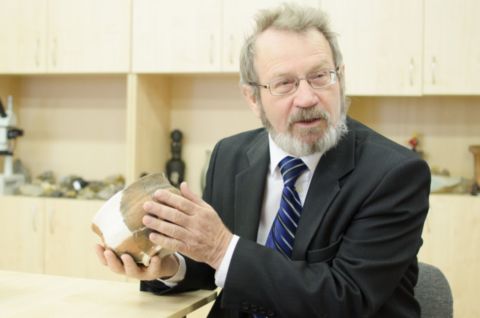From time to time, ancient copper figurines of warriors with quivers, weapons, and a bird on a shoulder are found in the South Ural region. They were made in the early Iron Age. Monuments to which peoples are they? What beliefs and cultural contacts are they evidence to? And what do the legendary Issedons, described by the ancient historian Herodotus, have to do with them?
In the summer of 2024, a joint article on the “New Figurines from the Forest-steppe Trans-Urals” by the Director of the Eurasian Studies Research and Education Centre, Aleksandr Tairov, and his colleague from the State Museum of the History of the Southern Urals, Alexey Shapiro has appeared in the Ufa Archaeological Herald journal. Despite the modest title, this is a large review work that sums up the discussions and research of archaeologists around Iron Age artefacts.
The South Ural region is a place where different landscapes meet: steppes, mountains, and forest-steppes.
Here the steppe nomads met with the inhabitants of the forest-steppes – semi-nomadic cattle breeders who had permanent winter settlements, and metallurgists (as archaeologists say: representatives of the Gorokhovo and Itkul cultures).
The steppe nomads worshiped the sun and fire and spoke the languages of the Indo-Iranian group. The Ugric peoples who inhabited the spaces to the north and west of the South Ural region worshiped anthropomorphic and zoomorphic deities.
Representatives of the Gorokhovo culture lived on the “cultural frontier”: they were connected both with the steppe people and with the Itkul metallurgists through economic and marital ties.
Ten years ago, two brothers Azamat and Rustam Gizatulins went fishing along the Sinara River, near the village of Karino in the Kunashaksky District. They found two figures of warriors with a bird on their shoulders: one was lying on the beach, the other was sticking out nearby from the cliff of the washed-out shore. The figures were covered with a green coating. When they were delivered to SUSU, employees of the Department of Metallurgy and Foundry, Professor Leonid Znamensky and Associate Professor Olga Ivochkina, confirmed: those were made from “pure” copper (98.3-99.4%).
“The model probably depicted a standing man with short arms spread out and down, slightly bent at the elbows,” A. Tairov and A. Shapiro describe the finds in their article. “Legs are straight, widely spaced, sexual characteristics...are somewhat hypertrophied. Obviously, a quiver is suspended obliquely from the left to the belt, from right to left. The head is small, the face is round, eyebrows, eyes, a long nose, and mouth are shown in relief... The elongated neck smoothly lapse into sloping shoulders. A long, slightly curved “offshoot” extends almost vertically upwards from the right shoulder... There is a figurine of an ornithomorph on the left shoulder...”
The archaeologists tried to identify the find by comparing it with other similar figurines found in the Southern Trans-Urals.
The most famous set is the Sapogovsky treasure. At the beginning of the 20th century, not far from the village of Sapogovo, a peasant, while ploughing a field, discovered a “treasure of twelve copper idols”. Part of the treasure was immediately lost. The village of Sapogovo no longer exists; the modern landmark is a kilometre south off the Novoburinsky settlement. The article analyses in detail the location of the discovery of the Sapogovsky treasure.
Previously, similar figurines had been found in the area of the Elevator settlement, Kunashaksky District, and also near Dalmatovo.
The Karinsky finds were made using similar models: the same theme, but in different casting moulds. Probably, the figurines from Karino, Sapogovo and Elevator settlements were made by different craftsmen. They differ from the figurines found in other regions of the Urals and Western Siberia. But the images of faces, quivers (gorits), and daggers have something in common with the images found further south - at Ustyurt in Kazakhstan. Thus, scientists come to the conclusion about a special type of “Sapogov’s anthropomorphs” - cast images.
Probably, the figurines personified fallen warriors: heroes, representatives of the semi-nomadic Gorokhovo culture.
The Soviet archaeologist Konstantin Salnikov, who had worked in the post-war years on the discovery of the Gorokhovo archaeological culture, had considered the Gorokhovo people to be Issedons, a semi-mythical people described by the ancient historian Herodotus.
The Gorokhovo people adopted elements of Iranian culture, for example, burials in mounds; other Ugric peoples had nothing like this. On the other hand, the warrior has a bird on his shoulder, and the steppe people did not worship animals. But in Khanty beliefs, a tattoo of a bird on the shoulder did not allow the bird-soul to move far from the person’s body, thus saving him from final death. Including the image of a bird (ornithomorph) for the Itkul culture, and sometimes several birds (for example, a small bird on the shoulder of a large one) is not uncommon.
“The leaders among the Gorokhovo people were Iranians; probably, when they were pushed south, the Gorokhovo tribes mixed with the steppe people. The steppe nomads were in the Southern Trans-Urals from May to August, and then left, and the Gorokhovo people stayed here for the winter and controlled the mining of metal, the manufacture of implements and weapons, representing the interests of the steppe people,” explains Doctor of Sciences (History) Aleksandr Tairov.
The leaders of the Gorokhovo people had been of the Iranian origin, probably, when they had been displaced to the south, the Gorokovo people had mixed with the steppe nomads.
Thus, a new concept has been introduced into scientific circulation - “Sapogovsky anthropomorphs” - another evidence of the uniqueness of the Gorokhovo culture, which arose on the Iranian-Ugric frontier, combining the features of two different civilizations. It is also a monument to the skills of the foundry masters who lived in the South Ural region two and a half thousand years ago.
The research is being conducted within the frameworks of the Science and Universities national project and supported by a grant from the Russian Science Foundation.




